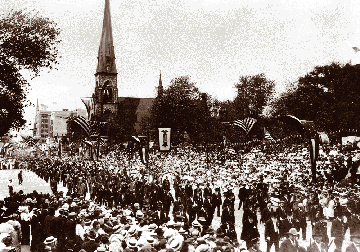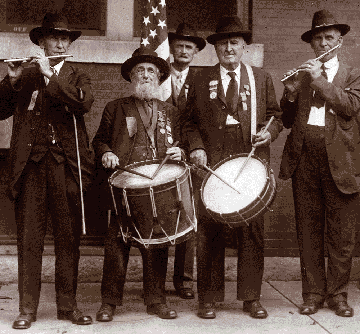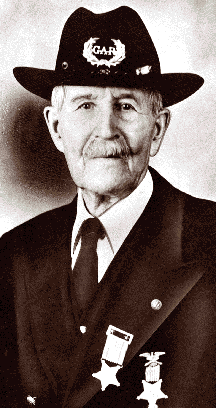The Grand Army of the Republic
By Jenny Nolan
After the Civil War, Union soldiers returned home, leaving behind hundreds of thousands of their dead comrades. Proud of the role they played in preserving the United States and in ending slavery, the veterans formed an organization to perpetuate the memory of their fallen comrades, to aid fellow soldiers fallen on hard times, and to extend help to widows and orphans of the war.
In 1866 Benjamin Franklin Stephenson and The Rev. W.J. Rutledge founded the first chapter of the Grand Army of the Republic in Decatur, Ill., with 13 fellow soldiers. At its height in the 1890s the organization boasted more than 400,000 members. Detroit was home to several flourishing and colorful Posts of the GAR.
In its early years the GAR was strongly partisan politically and considered itself the defender of the Union. When President Andrew Johnson fired Lincoln's Secretary of War Edwin M. Stanton in 1868 in a dispute over reconstruction policies, Gen. John A. Logan, then Commander in Chief of the GAR, rushed to Stanton's defense. Stanton refused to vacate the War Department, staying there day and night with Logan and the Grand Army at his side should Johnson try to take forcible possession of the department and control of the Army. Johnson eventually backed off.
It was Logan who inaugurated the observance of Memorial Day on May 30, 1868. The Grand Army also fought hard to win pensions first for disabled veterans and eventually for all veterans.

The GAR was known for more than its Republican politics and its work for veterans. They held national and state encampments around the country, giving the former soldiers, still young and in their prime, the opportunity to kick up their heels. Thousands attended these early conventions, which often became rowdy. However, as time went on and the veterans aged, the encampments became more sedate.
Detroit was home to the Grand Army of the Republic's F.U. Farquhar Post, Fairbanks Post, John Brown Post, O.M. Poe Post, and The Detroit Post.
The GAR built its own building in 1898 on Grand River between Cass and Adams on land that had been willed to the city by General Lewis Cass. Cost of the building was $44,000, $38,000 of which was given by the city and $6,000 by public subscription. The building still stands, though it has fallen on hard times. Since the demise of the GAR it served as offices of the WPA during the thirties and at some point as a police lockup.
The Fairbanks Post was chartered May 9, 1881 at Barnes Hall on Woodward and Grand River and was named in honor of Major John D. Fairbanks, who was wounded at Charles City Cross Roads, Virginia in 1862 and died a month later. The Fairbanks Post continued until its last member, Augustus F. Chappell died in January of 1942.
The John Brown Post was made up of freed slaves who had joined the Union Army. The post disbanded in the 1890's as members died or moved away.
The O.M. Poe Post was incorporated in 1903 and was named after Gen. Orlando M. Poe, commander of the Second Michigan. Poe was the builder of the Poe Lock at the Sault, and designed the Spectacle Reef Lighthouse in northern Lake Huron.
The Detroit Post was perhaps the most renowned. In 1887, four veterans met to discuss starting a new post of the GAR. They did not find a "congenial social atmosphere" in the existing posts, one of which had over 700 members. The founders were looking for men with a "congenial, clubby nature and the character and habits of a gentleman."
Sometimes called the Millionaires Post or the Silk Stocking Post, membership in the Detroit Post was limited to 150 members. New members were only admitted if someone moved away or died. Once in, a member was in for good, even if he could not afford to pay his dues.

The post was home to many notables including James Vernor, former chief justice of the Michigan Supreme Court Claudius B. Grant, publisher R.L. Polk, Gov. Hazen Pingree, brewer August Goebbel, newspaper editor John McVicar, and Samuel W. Burroughs, all of whom had fought in the Union Army.
The Detroit Post had its own uniform that was distinctly different that the standard Grand Army uniform of dark blue sack coat with brass buttons, trousers of the same material, and a wide rimmed black hat.
The Detroit Post uniform was a Black Prince Albert coat with black trousers, black shoes, standing collar, white bow tie, Grand Army hat with double gold cord, buff gloves, and black cane. The Detroit Post was renowned for its precision drill exhibitions.
At one national encampment, President McKinley was so impressed by their natty attire and perfect drilling that he asked to meet them personally. Once during a sweltering Louisville encampment, the Detroit Post was waiting by a church to fall in for the parade. The church members invited them into their basement for cool drinks and sandwiches. After learning the church was mortgaged, the post members raised enough money among themselves to buy the mortgage and retire it.

The Detroit Post had elaborately equipped rooms on Congress west of Shelby, with the "best of eats and drinks money could buy." They also possessed a great collection of war souvenirs, which was eventually donated to the Detroit Public Library. The building included an assembly room, parlor, library, and billiard room.
Two eminent Detroit veterans refused to join the Detroit Post --Gen. Alger, who stayed with the Fairbanks Post, and Gen. Poe who stayed with the post that bore his name. One day at the Detroit Club, they assured members of the Detroit Post that they would join if not for the fact that wearing silk stockings hurt their feet.
The final march of the Grand Army was in Washington D.C. on Sept. 23, 1936 -- about 500 strong. President Roosevelt was not in town.
In 1940, the Grand Army of Michigan encampment consisted of six veterans who refused to vote the Army out of service and went on to elect a new commander, pledging to carry on to the last man. The members were Augustus Chappell, 96, Albert C. Easterbrook, 92, Eugene Owens, 92, Martin J. Warner, 93, Orlando LeValley, 93, and David Plumadore, 95. During a parade of veterans of three wars, the six left the cars they had been riding in and walked in a faltering line of blue for the last block.
LeValley was the last native-born Michigan survivor of the GAR. He died in 1948 at age 99. He was born in 1848 in Lapeer County, tried unsuccessfully to enlist at the beginning of the war in 1861 at age 13, and finally got in at 16. He fought under Thomas against Hood at Johnsonville, Tenn. He died on the 80-acre farm he settled in 1876.
In 1951, the last Grand Army member in Michigan, Joseph Clovese, died at 107. Clovese was born a slave, one of a family of 15. He ran away and joined the Union Army and served with the 63rd Negro Infantry, taking part in the siege of Vicksburg. He came to Pontiac in 1948 from New Orleans to live with a niece.
As the ranks of the army grew thinner, their partisanship declined as well. In 1938, on the 75th anniversary of the Battle of Gettysburg, almost 2,000 veterans from both North and South returned to the battlefield and shook hands across the memories of the dead.
In 1956 the very last soldier of the Grand Army of the Republic, Albert Woolson, died at the age of 109 in Duluth, Minnesota, and with him died the last ember of a thousand camp watchfires.
